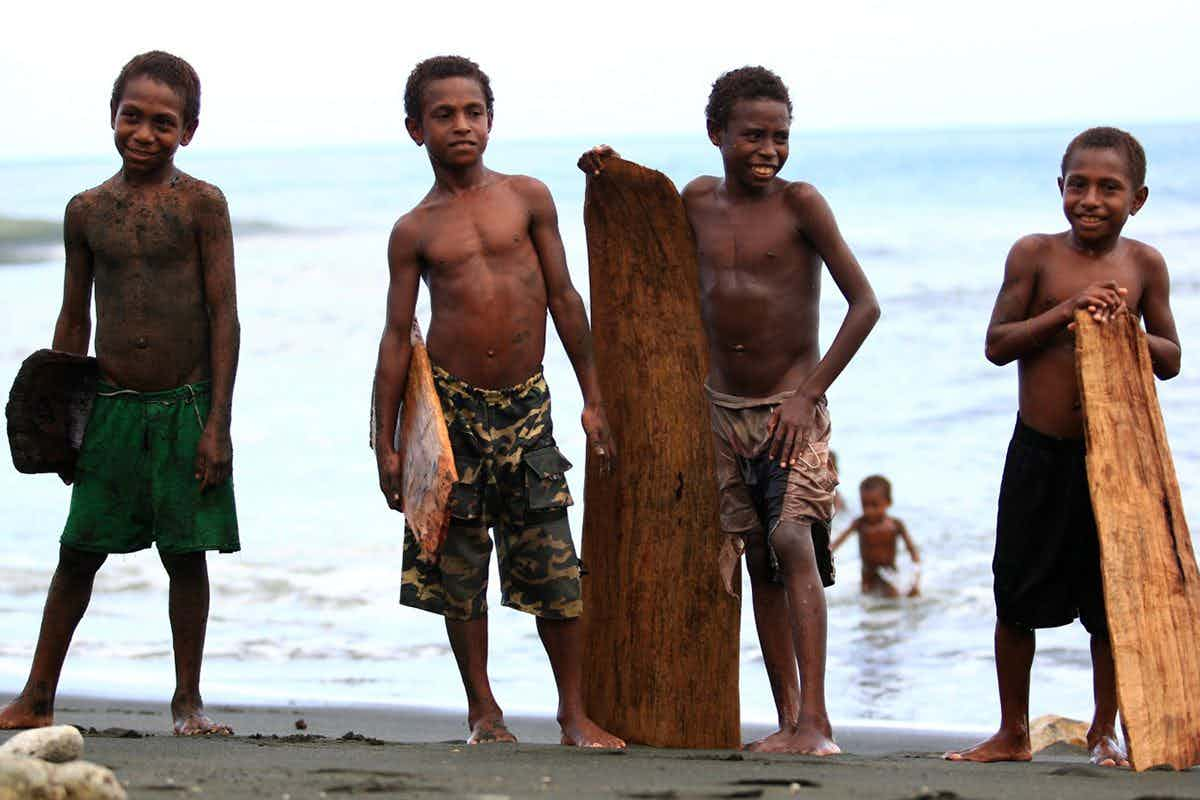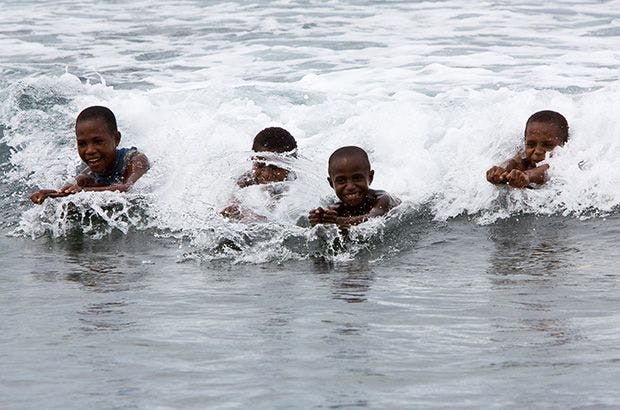Magazines, Surf culturePapua New Guinea: Surfing’s Splinter Group

Riding waves in Papua New Guinea has a long and fascinating history, and a very interesting future ahead of it.
For hundreds of years villagers in the remote coastal communities around Vanimo in Sandaun Province have been surfing prone on wooden boards known as “splinters”. These basic surfboards (called “palangs” in local pidgin) are carved from tree trunks or pieces of abandoned dugout canoes using axes and machetes, and are evidence of a culture of riding waves that dates back several hundred years and that, it would seem, developed entirely separately from the wave riding culture of the Polynesians.

Like any culture in a remote part of the developing world though, when the wider world of surfing finally started to make its presence felt then surfing in Papua New Guinea began to catch up rapidly. The development of surf culture and most notably surf tourism in PNG could have taken any number of directions however, were it not for the stewardship of one man with a strong vision for how surfing should have a positive impact upon his country; that man is Andrew C. Abel, ML commonly called Andy.
Andy was born into an influential family with a strong track record of bringing about social change; his grandfather, the Reverend Charles Abel, was a missionary who arrived in Papua New Guinea in 1891 and founded the Kwato Church having been expelled from the London Missionary Society for his radical ideas about educating indigenous people without damaging their culture, and his father, Sir Cecil Abel, KBE, OBE, was a pioneering statesman who guided Papua New Guinea towards independence and was one of the chief architects of the nation’s constitution. Andy clearly had some significant shoes to fill, and has done so using his passion for surfing as a guiding influence. As a teenager Andy broke his leg in a motocross race and was eventually sent to Brisbane, Australia, for treatment after the Doctor who set his leg in a cast in PNG misaligned it and left his broken leg 1cm shorter than it should have been. Andy convalesced on the Sunshine Coast for the following three months, which was where he first came across surfing. Determined to learn to surf when his leg was healed, he managed to convince his father to let him stay in Australia to finish senior high school before returning home to Papua New Guinea. This all happened at a time when the issues of land rights and resource management were coming to the forefront of current affairs in PNG; local opposition to the open cut mining of copper by Conzinc Rio Tinto in Bougaineville had led to an armed uprising and a conflict that persisted between 1988 and 1998 and resulted in between 15,000 and 20,000 deaths. This escalating conflict had a profound impact on the young Andy, who resolved to never let his newfound passion of surfing be exploited in his homeland at the expense of the local communities.

In 1989, having recently returned to Papua New Guinea, Andy was alerted to the quality surf breaks and the wave riding culture around Vanimo by a friend who was a pilot for Talair. Before too long he had, along with his friend the Hon. John Tekwei, founded PNG’s first surf club at Vanimo. They taught local children to surf and Andy donated his own modern foam and fiberglass surfboards to the improving local surfers, and before too long Andy began to see the potential to marry his love for surfing with the opportunity to develop sustainable tourism as a way to both support the growth of surfing there and benefit the local community. Andy’s bottom-up approach, which he refers to as the “ Abel Reverse Spiral Model”, was his way of bringing about change in the local community by empowering local surfers and landowners to influence how surf tourism developed at the surf spots on their tribal lands. Having travelled to other countries to surf in the region, Andy had witnessed firsthand both the benefits that surf tourism could bring to an area as well as the negative impacts (such as the purchase of exclusive access rights and foreign investors profiting at the expense of locals) and he was committed to ensuring that Papua New Guinea learnt from the lessons and mistakes of others. Surfing in PNG had a long history of riding waves in isolation but also the opportunity for a fresh start in the way that it moved forward. Andy was also keen to seize the chance to use the growth of surfing to tackle the issue of domestic violence towards women that had become a major problem in PNG; no small task in a traditional and strongly patriarchal society.

To help achieve all of this the newly formed Surfing Association of Papua New Guinea Inc (SAPNG), with Andy as it’s President and Founder, initiated a club structure and a Surf Management Plan so that each surf spot or village with a population of surfers had its own surf club. The people own 97% of the land in Papua New Guinea, including the fringing reefs, so the traditional customary clans are able to control access and usage of their custodial lands. The surf club acts as a representative of the local village or clan as local resource custodians of the surf spot, allowing them to negotiate on, plan and manage surf tourism on their coast in a sustainable manner. This is achieved through capping the number of visiting surfers and charging each visiting surfer a fee (around AUD$50 to SAPNG through its registered wholesalers and then AUD$12 per day per surfer) which is paid out end of the surf season in the host surf club and the local community to fund projects that address and improve issues such as water sanitation or the improvement of educational facilities.
“A strong sense of duty has driven me over the past 28 years to establish a truly home grown sports-tourism model that ensures current and future generations are in control of their destiny, with the “ horse before the cart” and not mere beggars and bystanders in their own land.”
Further to this, the charter of the SAPNG requires all affiliated surf clubs include women in their administration and in competitions, in line with ISA regulations. Because the Surf Management Plan places local surf clubs at the heart of each surf community, the result is that surfing is effecting real and meaningful social change in these communities by empowering female surfers as equals in the water and as decision makers within their communities.
“We now receive surfboard donations from Australia and Japan and half of them are painted in line with the new policy that I created, called the Pink Nose Revolution, so that they are destined for use solely by PNG’s female surfers. The aim of this is to empower women with equal rights and opportunities and thus help combat violence against women.”
By initiating a club structure (similar to that which exists in nearby Australia), there is an organised, democratic and accountable body present to control the development of surf tourism at each location, and the standard of local surfing and the opportunities that arise off the back of it improves rapidly through events such as interclub, national and regional competitions and a planned SAPNG-World Surf League (WSL) event.

Andy Abel could have done what many surfers might have done and kept the waves of Papua New Guinea a secret; he probably would have enjoyed perfect, tropical, uncrowded waves for the past twenty eight years. Instead, he considered a future that might involve the “discovery” of the waves in PNG and their subsequent unchecked surf-colonisation, and he chose to use the opportunity to influence the development of surfing in his homeland for the good of his fellow countrymen. There are no doubt local communities at a few “idyllic” surf locales around the world that can’t help but wonder how their home might have ended up if they’d had someone like Andy Abel fighting their corner.
The development of surfing in Papua New Guinea is the subject of a brilliant documentary film by Adam Pesce titled “Splinters”. You can check it out on itunes by clicking here.